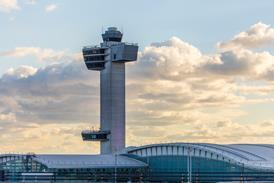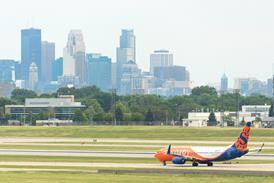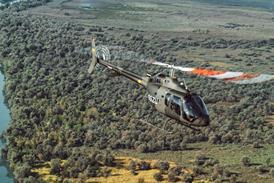US airports only know one thing for sure about the new security rules: that they will cost plenty. But just how much, who will pay and how to accommodate the costs and the security devices remains uncertain
US airports have always had to work in something of a three-ring circus. They must juggle the competing claims not only of airline customers and the public at large, but also a set of political masters stretching from city hall to Capital Hill. As if this were not already dynamic enough, a further ring master has since emerged in the wake of 11 September. It comes in the shape of the Transportation Security Administration (TSA). So, complains Jim Wilding, head of the Metropolitan Washington Airports Authority, there are at least four rings now in play and there may be more to come.
It does not help that the TSA's agenda remains unclear. The new federal authority has yet to decide exactly what orders it will issue to airports on what kinds of security devices to install; where to install them; how to use them; or how to pay for putting them in. As a result, says Wilding: "We don't know what to build or where to build it."
The uncertainty imposed by the TSA may well be understandable because the agency, created last year, does not itself yet know the answers to these questions. Looming over the TSA - and so over the entire airports community - is a year-end deadline imposed by Congress for full-bag screening and a 19 November deadline to have a fully federalised screening workforce in place.
So, in the words of David Plavin, president of the Airports Council International-North America, all that is certain is that the basic concept of airport thinking has changed. The principle used to be that passenger convenience was the first criterion, giving customers a roomy feeling by making airports spacious and visually discursive. Now the goal is precisely the opposite: to make airports into crowd-control machines, reducing space intentionally.
"Airport managers would like to return to that old principle, but Congressional mandates on security and other requirements conspire to make that difficult. Even with the least intrusive mix of security technology, you're talking about a lot of people and a lot of space," says Plavin.
Counting the cost
No one in the airports world is certain about how the mix will turn out, but one absolute certainty is that airport security will come at a steep cost, in terms of both dollars and hours. The Department of Transportation's inspector general, Ken Mead, has estimated that the airports would be liable for about $2.3 billion in construction costs to accommodate the explosives detection machines that are needed.
James Gilliland airport analyst at the Fitch ratings agency believes that this estimate could be too low. It is already clear, he says, that in many cases, parking garages will need to be rebuilt, rental-car facilities relocated and concession space removed. All of these assets represent key revenue producers for airports. Gilliland adds airports with landside restraints - principally older large-hub airports - will suffer the most. Included in this list of airports with little or no room to expand are Los Angeles, Chicago O'Hare, Atlanta, Newark and San Francisco.
It could be worse. Responding to a rising cry of anguish over a steadily climbing price tag, Transportation Secretary Norman Mineta in April modified his policy in allowing for the use of a mix of screening devices, rather than solely of the large Explosive Detection System (EDS) machines.
The introduction of smaller, lower-cost explosives trace-detection (ETD) machines to the requirements brought a collective sigh of relief. American Association of Airport Executives president Charles Barclay added that even if full screening using ETD technology by the end of the year made sense, it "would not be achievable" by year end.
Allowing a mix may gain some breathing room, but it is still challenging for each airport to design its preferred blend of technology notes Kevin Cox senior executive vice-president at Dallas Fort Worth. After a $2 million consultant study, DFW proposed an "in-line" blend of 40 EDS machines with its existing baggage-handling system, with 20 backup machines. A price tag of about $194 million comes with the job of making room for the big machines.
Although DFW will not have to reinforce its floors to support the minivan-sized EDS machines, as will some airports, it will face costs in rearranging areas laterally. Cox says the airport needed a mid-April commitment from the TSA that its plan was acceptable but "they were unable to commit to that deadline".
Whatever the eventual time that decision becomes final, airports are looking at costs they never thought they would have to face. The Seattle Tacoma airport would have to do some floor-reinforcement work and is contemplating a total bill of as much as $35 million, while in Las Vegas, McCarran airport could lose as many as four gates to install added machines. Likewise, Miami is facing $18.7 million in extra costs to reconfigure and to support security.
Even the relatively new Denver facility may have to put out between $65 and $85 million, while at Philadelphia, the new requirements would cost about $85 million this year. Most of this would be spent on rebuilding terminal areas to accommodate EDS machines and $5 million in added personnel costs, mostly for police overtime.
Insurance is also an issue, as it is for the carriers themselves. Basic coverage premiums have gone up by 25-50%, while war-risk and terrorism insurance, which had often been included as part the basic policy, is now usually offered as a separate option. In Pennsylvania, liability costs rose by about 150% since September.
Even as cost estimates for security refitting rise, the pool of federal funds is uncertain and in some cases shrinking. Congress allotted an extra $175 million to aid airports for unexpected post-September security costs, but had received $464 million in requests for grants from this fund by late April.
Who will pay?
No extra reimbursement funds are yet set for the next fiscal year. TSA policy is to grant airports $175,000 per machine to help pay for installation, a figure that will likely become more generous as Congress hears more from airport officials back home. It is the shrinking size of the pool that has some worried.
The basic pot of Airport Improvement Program (AIP) grant funds was fixed at $3.2-3.3 billion through fiscal 2002, while the administration now plans to raise that total only slightly to $3.4 billion for fiscal 2003. However, just getting to that sum may be a battle. The $3 billion level was only reached because it was pushed through as part of the wider three-year AIR-21 FAA reauthorisation bill which had been argued over for years. AIP levels had been in the range $1.7-1.95 billion before increasing airport congestion spawned the political will to pass AIR-21 in April 2000. The rising cost of airport security also worries lawmakers, many of whom have "sticker shock" at the price tag of having to hire twice as many screeners as expected.
The administration has requested $4.4 billion in separate money for the TSA on top of the $1.3 billion already budgeted. That is almost as much as the $4.8 billion proposed TSA budget for the 2003 fiscal year starting in October. Personnel costs drive the increase as much as do the costs of buying the detection machines.
Senators are hearing complaints from hometown airports that the funds are not coming their way. One Senator, Mississippi Republican Thad Cochran, said it was "not good news" that the DoT would not increase funds for airports that must undertake construction to meet security mandates.
The airport in Jackson, Mississippi, was told it would be reimbursed for about half the added costs, Cochran said. Secretary Mineta told Cochran and others on the money-spending Appropriations Committee that airports can use their regular AIP grants to cover some of these extra costs, because the expansion that the grants would normally fund will not be needed this year or next because of the slowdown. At this, the Senate's senior member and the committee's chairman, West Virginia's Robert Byrd objected, shook his head and called Mineta's explanation "a poor answer".
Other senators are worried that the increasing demands of the TSA will add to the fiscal tension between security and capacity and safety needs. Senate Appropriations Transportation Sub-committee chair Patty Murray, a Washington state Democrat, calls it "most misguided" that the FAA has already asked that $100 million be transferred from a capital improvements fund to security.
Meanwhile, post-crisis airport revenues remain stunted. Concession and airline-fee revenues will likely drop by about $2.3 billion or about 19% in the 12 months after September 2001, while the aviation trust fund - the source of much of FAA's airport spending collected from ticket taxes and cargo bills - could slide by about 20%. Concession revenues are a spot that, if not bright, are not as dismal as feared, as passengers are spending more time at airports because they have to arrive earlier, and because airline cutbacks in food services have encouraged more food-buying in the terminal.
Projects on hold
So what are airports doing? Most capacity projects are being deferred but not cancelled says Fitch's Gilliland. About $20 billion in projects has been put on hold, he says. At DFW, the airport cut its $310 million annual budget by $27 million. Some airports have raised their landing fees, adding another element of conflict.
Airlines do not want to absorb the added costs or pass them along to customers in the midst of a recovery that seems to be stumbling. The Port Authority of New York and New Jersey, which runs the three New York City areas airports, has raised landing fees to recover some of its increased costs, says spokesman Greg Trevor.
Fees at JFK have gone from $3.70 to $5.50 per 1,000lb takeoff weight and from $4.90 to $5.90 at LaGuardia. At other airports such as Raleigh-Durham, North Carolina, or the Lehigh Valley airport in Pennsylvania, landing-fee increases since September have been at around 30-40%. Analyst at credit rating agency Standard & Poor's Kurt Forsgren says he is surprised that the fee increases have not been widespread.
Other airports are contemplating raising the passenger facility charges collected through tickets where they can (see table below). If DFW does not get reimbursed for security modification costs, it could raise its PFC from $3.00 to $4.50 per enplanement, says Cox. That's a move few will take readily because passengers notice add-on fees. Nearly half of the TSA's $4.8 billion budget will come from a new $2.50-per-segment security fee collected from passengers.
That has already drawn objections from airline passenger groups, and protests have stemmed a move to double the fee, at least temporarily. Delta chief Leo Mullin says that taxes and fees on a $200 airline ticket are 26% of the total price, up from 15% just five years ago.
Airports are worried that security costs will push up passenger fees, and, fears Washington's Wilding, the added fees coupled with increased queuing time and other airport hassles could "eventually lead to a passenger revolt."
Innovations
Faced with the possibility of having to write a blank cheque, some airports have taken simple, low-tech steps. Atlanta has painted footprints on the floor to help guide passenger lines and, to keep lines from bunching up. The airport has also installed glass-partitioned areas so that those selected for extra screening will not delay the major line. Others have installed hard-wired metal detectors and EDS machines that cannot become unplugged, which has in the past meant hours worth of passenger rescreening.
At Dallas Love Field, seats have been added near baggage-claim carousels for those waiting to meet passengers; greeters at gates have been banned by security rules. Express check-in lanes for the most-frequent fliers have been added by the airlines, even though the concept created a problem for the TSA at first.
The agency said it did not endorse the principle of separate treatment, but backed down when the airlines reassured it that all passengers - including the elites - would go through the same security checkpoints. The TSA also has stepped into queue management, turning for guidance to advisors that include Walt Disney.
The next year will hardly be a holiday for US airport operators. "My fear is that the uncertainty over what we are going to have to get and where we will have to put it may well last into next year, regardless of the deadlines that Congress imposed," says Plavin, adding that the TSA faces an enormous task given the strictness of the congressional mandates.
After congressional clarity allows airports and the TSA to communicate more, and airports have some certainty, they will know what must be done.
Source: Airline Business























